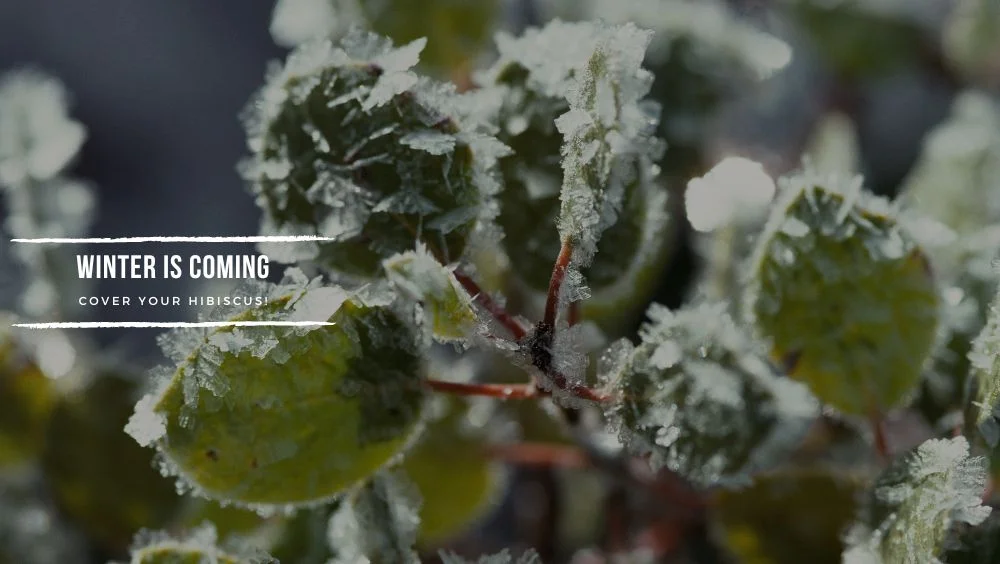
Starting November, temperature drops can be sudden. Which is why, averting any kind of damage to beloved Hibiscus should be your number one priority. But before doing so, you need to know how to proceed. Below you can read how to cover your hibiscus with things that almost everyone has at home.
Does Hibiscus Need To Be Covered?
Any tropical plant that grows in areas characterized by harsh winters needs to be protected from the vagaries of the weather. Hibiscus is no exception, although it also depends on the particular variety of mallow you have.
Hibiscus Syriacus, for example, are hardy and will die in winters before growing back again in the spring (technically making them herbaceous perennials). On the other hand, warmth-loving Hibiscus Rosa Sinensis (common name: Tropical Hibiscus) needs to be protected, either by bringing them indoors or by covering them if they are grown as garden plants. If not, they may die completely and, disappointingly, will not regrow again at the end of winter.
At What Temperature Should I Start Covering My Hibiscus?
Being a member of the mallow family, Hibiscus comes in more than 200 different varieties, from trees to bushes, perennials to annuals. In North America however, Hibiscus rosa-sinensis (Rose Mallow) is the most common variety available in nurseries or in garden stores.
This particular variety of Hibiscus does not tolerate frost as it favors warm climate to grow and propagate (temperature ranging between 18° to 35°C is ideal).
So, in case you are growing such variety of Hibiscus, remember, it is a tropical plant and tropical plant will not tolerate more than a night or two of frost. Even one night below sub-zero can kill it completely. Which is why, it is important to act as soon as the temperature drops around 5°C at night to avoid any kind of damage.
By Which Month Should I Cover My Hibiscus?
By November, it can get extremely cold at night, while still being warm during the day. This type of weather is most dangerous because it is then that the hibiscus suffers most damage.
Rapid freezing at night, followed by intense sunlight during the day, will cause the plant’s cell walls to burst. For this reason, you should cover your hibiscus if it is growing outdoors, and for potted plants, consider bringing them indoors.
In general, gardeners should make it a habit to monitor the weather forecast and then act accordingly. And unless a breathable translucent fleece is used, covers must be removed the next morning as soon as the temperature rises above freezing. This will ensure that the plant follows its natural cycle of food production and thrives well outdoors.
How Much Warmth Should The Covers Provide?
Most frost-sensitive Hibiscus plants will go dormant for several months in colder temperatures, but will continue to grow if you keep them warm.
However, things get little difficult here in the north of America with our long, harsh winters, as there is simply isn’t enough sunlight to promote healthy growth.
Eventually the shoots lose their rich green texture and look wilted. Which is why, it is important to maintain the temperature under the covers somewhere between 10-15 °C, by introducing artificial warmth and light.
But its fine if you do not want to invest in something like this, and you can simply stick to covers. Do remember that your hibiscus will then take a break from growth and save its energy reserves to sprout stronger the next spring.
Do I Need To Cover Hardy Hibiscus?
Even hardy hibiscus plants, which are otherwise considered to withstand adverse conditions, suffer considerable damage in winters. So, it is equally important to protect them using covers made from fleece or jute to create a thick insulation that regulates the temperature around the plant. Particularly those grown in pots, because in the event of frost, the entire root ball can freeze completely.
The chances of root frost for hardy hibiscus planted in the garden soil is much less as some amount of heat is always present in the deeper layers of the soil. The frost in this case penetrates much more slowly and less deeply than with plants grown in pots.
All in all, both hardy and tropical hibiscus grown in pots or in garden beds should be protected from sub-zero temperatures by adopting suitable measures.
Advice: For grafted hibiscus, apart from covers, the soil around the plant must be layered with bark mulch and ideally with some topsoil heaped up to a height of around 10 inches. Moreover, the grafted portion should be additionally covered by a plastic film.
When To Remove Covers From Hibiscus?
While it is understandable to be excited, don’t rush into removing the winter protection. Starting from March, you may consider removing the covers from your hibiscus plant. However, in the case of some sensitive hibiscus plants, ones that witnessed winters for the first time, protective fleece should remain a little longer.
This is because the threat of ground frost is not completely eliminated in March. Which is why, you should wait till the temperature is at least 10°C during the day.
On the other hand, it is perfectly fine to uncover large hibiscus trees and mature plants that have survived outdoors for more than one winter season.
Do remember while uncovering that the sun should shine on the ground for a long period of time and that the soil is absolutely frost-free. Rushing things up can be risky, especially for young shoots. There are chances that you might experience frosty nights at this time of the month. So, it is advised to keep covers such as bubble wraps nearby. This will allow you to react quickly in case of sudden weather changes.
Which Material Should I Use To Cover Hibiscus Plant?
Any material that has an insulating effect and is easy to wrap around the plant can be used as a winter cover for hibiscus. Materials that keep out chilly winds and allow light to pass through are suitable for protecting the roots. However, they should be permeable to allow some amount of air to pass through.
As an example, thick mats or plastic films with air bubbles (usually used while packing fragile items) can be used as an effective protective cover. Since air is a poor conductor of cold, the heat that potting soil traps during the day will be retained in the night as well.
If you search for “frost cloths” on Amazon, you will find a variety of frost protection covers. Some of my personal recommendations that are cheap and readily available are:
- Jute
- Fleece
- Used blanket
- Bubble wrap
- Thick bed sheets
Best Ways To Cover Hibiscus Plant In Winters
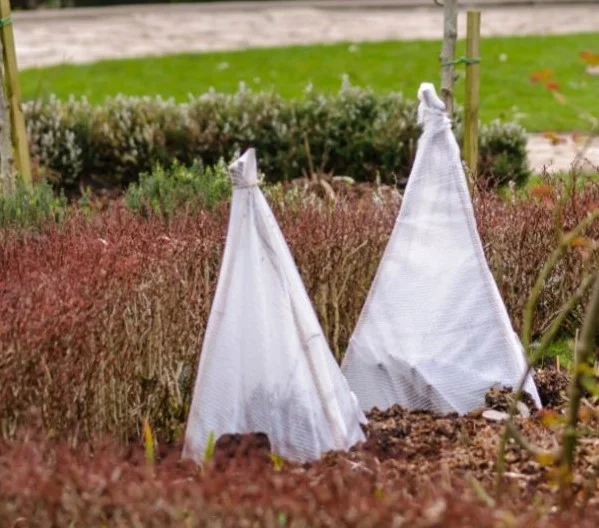
Classic Method: Fleece
When the nights are freezing cold, fleece can come in really handy. This soft napped insulated fabric is made from polyester and has many benefits including its wear resistance and quick dry properties. If used properly, this fleece can last for several years.
And besides its insulating capabilities, it also retains the thermal energy from sun thereby keeping the plant warm during the night.
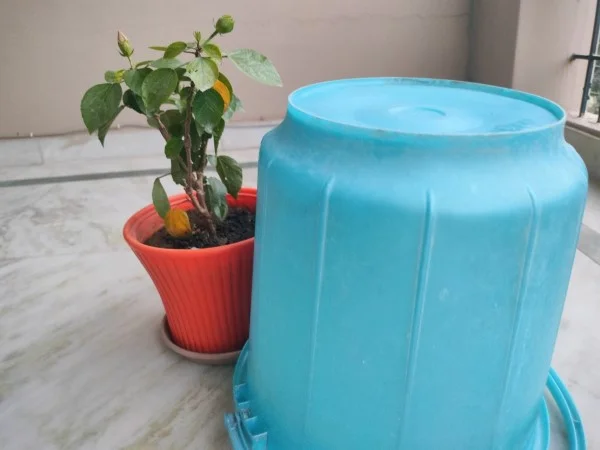
Economical Method: Bedsheet and Bucket
While this technique may seem inefficient, believe me, it delivers the same results that you get from fleece. Curtains, bed sheets and sofa covers that are no longer used indoors can be used as a temporary solution to prevent your plant from cold. All you need to do is place a large bucket over your hibiscus plant and cover it with an old bed sheet or curtain fabric.
An added benefit is that the bucket will protect your plant from a snowstorm, while the cloth over it insulates it to some degree.
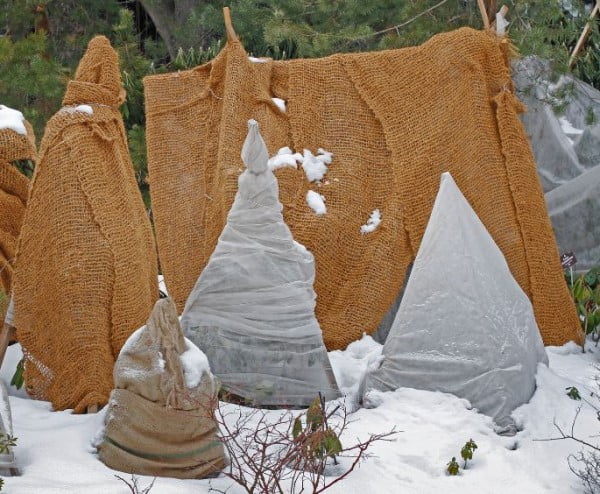
Wise Method: Jute Covers
Using sacks of burlap or jute to cover hibiscus is one of the surest ways to ensure that they survive the harsh weather. This is because this material is quite thick and therefore insulates the plant to a great extent. It also helps prevent winter burns caused by a combination of harsh weather and sunlight.
These sacks of jute or burlap can be wrapped around the plants to protect them overnight. However, owing to their construction, they are not translucent or very permeable – so they should not be used for extended periods of time or should be opened from time to time during the day.
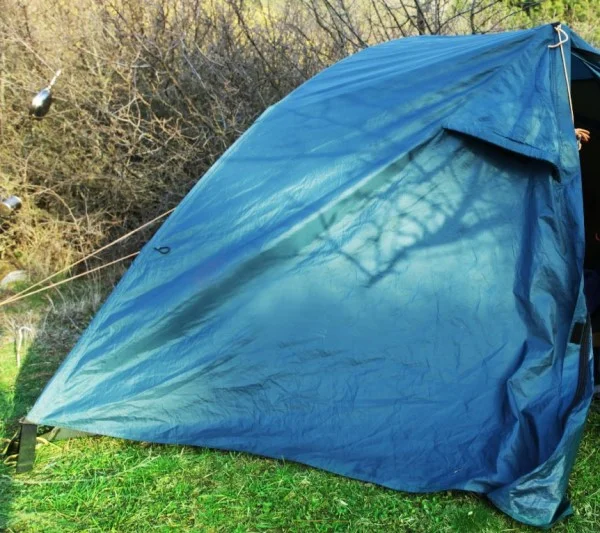
DIY Method: Tent House
Just because there’s a risk of frost for a few months doesn’t necessarily mean you need to invest a lot of money in your garden. I’m sure that you, as a gardener, are a fun-loving person. So why not use some DIY techniques to get around the problem?
Have you ever been camping in the winter? You can use the same technique to prevent your Hibiscus from harsh weather. Dig a few holes in the ground and stick some wood in a semicircle pattern over your plant. Then throw a bed sheet, tarp, bubble wrap or anything you can find that will let light through. Just make sure everything is covered and the fabric reaches the ground.
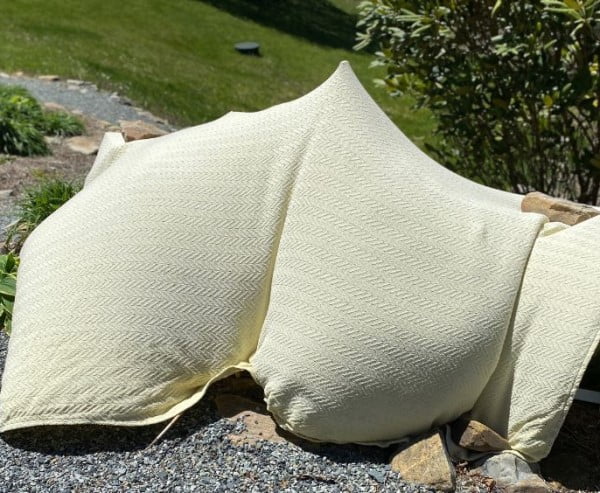
SOS Method: Blanket
A blanket can be used as an emergency alternate if you somehow forgot to prepare in advance. This SOS measure also helps protect larger potted plants that are difficult to move indoors.
And don’t think that this technique is any less effective. After all, anyone sleeping outside in the cold will be grateful if you offered them a blanket. But as it happens, sometimes the blanket can break the tender stems or buds. So, I would advise putting some strong sticks either in the pot or around it to give the blanket some support.
Other than some amusing comments from the neighbors, this method will completely protect your plant from frost.
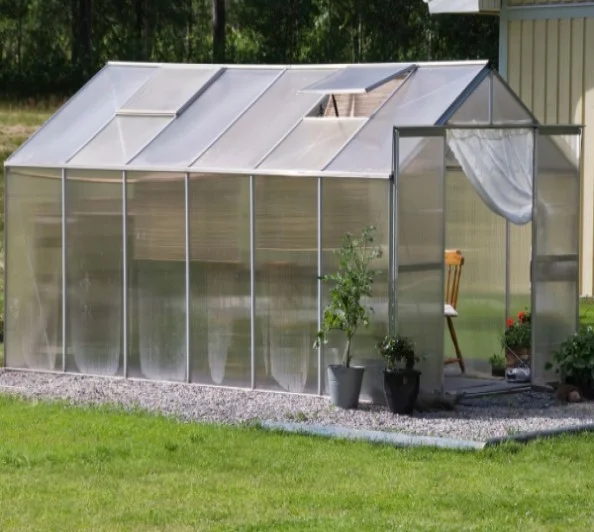
Reliable Method: Greenhouse
Surely you can use cardboard boxes, sheets, blankets, fleece or anything else that is capable of protecting your plants from frost. However, it gets pretty difficult for a plant to maintain its natural cycle under these conditions. Which is why one of the most ideal (although not economical) ways to protect your Hibiscus plant from frost is by installing greenhouse tent in the garden.
This so-called greenhouse tent will protect the delicate tropical plants from frost by providing a warm atmosphere both during the day and night, thereby preventing them from going dormant. In addition, sunrays can easily penetrate the transparent layer of the tent, allowing the plants to bloom almost equally all through the year.
And since you will be controlling the environment by regulating the temperature, you no longer have to worry about frosts. On top of that, it’s only a one-time investment- so you can grow Hibiscus (or any other tropical plant) for many years to come.
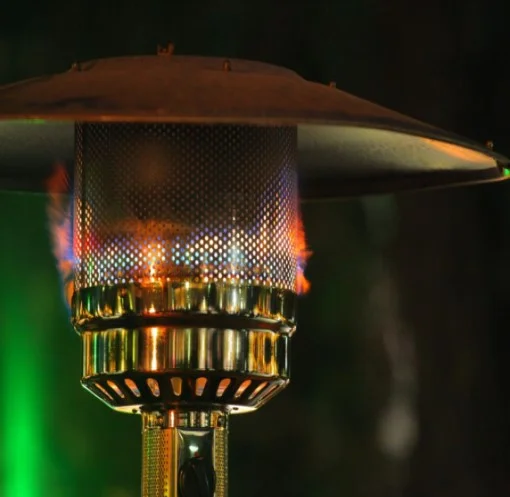
Popular Method: Patio Heater
If neither of the above ideas appeal to you, then perhaps it’s time to take the most contemporary approach. A patio heater, available as a wall-mounted, floor-standing, hanging, or tabletop design, warms up a garden radius of around 5 meters. They are wonderful, effective and maintain the aesthetics of the garden.
Plus, they are available in many different shapes, sizes, and in many economical options as well such as wood-burning patio heaters, fire pits, and chimneys. As an added advantage, they make it quite convenient to extend your in-house party into the garden area as well!
Bottom Line
Winter is the only season that threatens our beloved hibiscus. This is why it is extremely important to protect them, save them and cover them from this harsh climate. But no matter what method you choose, remember to mulch the area well along with periodic watering.
Most importantly, your hibiscus will need some air and sun during the day. So don’t forget to uncover them so that they can enjoy this time of the year as well.
Have fun gardening

